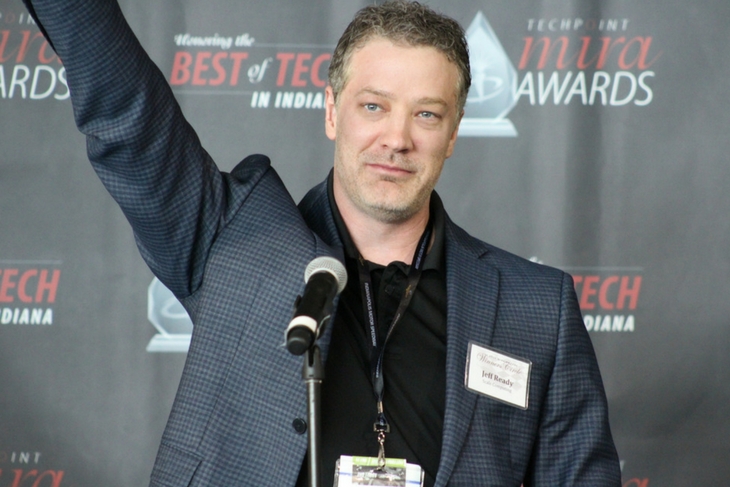Google & Scale Computing collaborate to bring on-premise apps to the cloud (and back)
Scale Computing, a market leader in hyperconverged solutions, recently announced that it is working with Google to develop a hybrid cloud solution that makes it easy for organizations, including channel partners and MSPs, to move application workloads freely between the cloud and on-premises.
The new offering, called HC3 Cloud Unity, allows an organization’s apps to use resources in the cloud and on-prem at the same time, and enables apps solely created for on-prem to now run on Google Cloud Platform.
Hyperconvergence, the bringing together of servers, storage and virtualized software into a single stack to take advantage of advances in computing power, was first invented in Indianapolis by Scale Computing — and they have 27 patents backing up that claim. The company also recently moved into The Union 525 scale-up tech campus and saw a record 68 percent revenue increase in 2016.
I spoke with Jeff Ready, CEO of Scale Computing, to dive into this tech-talk and understand what this partnership means for Scale Computing, Google, and the tech community.

In layman’s terms, explain to our audience how Scale Computing’s new HC3 Cloud Unity platform works and what benefits it provides to the industry.
In short, it takes the resources of Google’s cloud and makes them appear to be a part of your own network. Typically, “the cloud” is one thing to manage, and it’s completely different than managing your own network, which means extra complexity and overhead. We make this all part of the same environment, so that adding Google Cloud into your network is no different than adding one more sever into your network.
What businesses will benefit from this new partnership? Can you give some real world examples of the on-premise apps that can now be run on Google Cloud? Why is it so difficult to move legacy applications to the cloud?
Typically “moving” an application to the cloud actually means rewriting the application to be cloud based. There are lots of companies who have made a business of doing that for specific applications. Salesforce, for example, was CRM (customer relationship management) redone for the cloud. This rewriting is needed because the cloud environment is completely different. That’s fine if you are talking about apps with a broad appeal, like CRM. But what about niche apps, custom apps, and the like? Rewriting apps is expensive, takes a lot time, and can be very daunting. What HC3 Cloud Unity enables is that those applications which are running on-premises can now run in the cloud without any changes whatsoever. And, equally as important, is that once in the cloud, they can be moved back on-premises the same way.
What cost savings does this provide businesses?
With this, adding cloud capabilities is turn-key. Nothing needs to be rewritten, which saves money, and nothing needs to be relearned, which saves even more. In addition, this is a great way for companies to implement disaster recovery with the ability to have their systems fail-over into the Google Cloud in the event of a disaster. We see that as being the biggest in-demand area right now — and no surprise with the natural disasters over the past few months — that customers want the ability to use something like Google Cloud, but previously didn’t see a way to make their apps run there. Now if their systems go down in a hurricane, flood, or fire, everything can quickly come back online inside the Google Cloud so business can continue.
We know Scale Computing has roots in Silicon Valley. Did you meet with Google in the Valley produce this relationship? How did it come about?
We met Google about two years ago at a conference in Silicon Valley. It was engineering in nature, and we started talking because the architecture of the Scale HC3 platform we were deploying in our customer’s data centers had many similarities to the way Google was architecting their own cloud. One thing lead to another, and when they were looking to connect on-premises systems with Google Cloud, partnering with us made a lot of sense because the underlying systems were so similar.
Scale Computing has grown significantly over the past year in both revenue and partnerships. What’s next for your company that we should be on the lookout for?
The big trend you are going to be hearing about over the next several years is called “edge computing” — which basically means seeing applications running at the very point where data is collected — in essence at the opposite end of the cloud. There are more and more internet-enabled devices out there: sensors, cameras, and the like, and there are situations where it makes more sense to do the computing on that data at the point of collection, rather than send that data upstream to a datacenter or to the cloud. You don’t want your self-driving car checking with the cloud to decide if it’s time to stop — you need that decision to be made locally. That’s edge computing.
At Scale, what we are enabling is for our customers to have a single, easy to manage environment than encompasses all of this from cloud to data centers to edge computing, so that they can run their applications in any of these locations, all of these locations, or move them around between them. There is always a push-pull between centralized computing and distributed computing. Mainframes were centralized, PCs were distributed. Now we’re talking cloud is centralized and edge is distributed. Our goal is to build products that enable customers to be successful in all of those environments.
Interested in learning more about Scale Computing? Read their featured profile and view their Tech Directory profile to stay up to date on job openings and other announcements.



